Serie + Multiply with CPG, complete the Tallest Government Building in Singapore – The New State Courts Towers

- At 178 metres high, the new State Courts Towers is the tallest government building in Singapore, to date. It is also one of the world’s tallest courthouses.
- The new 35-storey State Courts Towers comprises two towers, the “Court Tower” and “Office Tower”, which are connected by 39 link bridges.
- The modern courthouse is fitted with 53 courtrooms and 54 hearing chambers.
- The Court Tower has a series of landscaped terraces with variable heights on which the courtrooms are placed — there is no external glazed facade.
- The courtroom facades are made from pigmented and stained pre-cast panels — these allude to the roof colour and texture of the shophouses in neighbouring Chinatown.
Nearly two years after the Topping-out Ceremony officiated by The Honourable the Chief Justice Sundaresh Menon, the new State Courts Towers standing at 1 Havelock Square today is fully operational and is the tallest government building in Singapore to date. The new State Courts Towers was designed by Serie + Multiply Consultants Pte Ltd, winner of a public two-stage Open Design Competition organised by the State Courts in 2011. The project was developed and completed in collaboration with CPG Consultants Pte Ltd who is the Principal Consultant and Architect.
Courtroom complexes are typically designed in a conservative manner partly due to complex circulation requirements to keep the Judges, Persons-in-Custody, and the Public separate.
Christopher Lee, Principal at Serie Architects, UK comments, “The relationship between the city and its civic buildings was our primary interest for this project. The new State Courts Towers should be a building that is symbolically open and accessible to the public. Its design language is drawn from the architecture typical of the city and hence is both familiar and surprisingly new to its citizens.”
In contrast, the new State Courts Towers have been designed to be highly open and visible to the public. This is achieved with two architectural strategies. First, the building is split into two slender towers connected by link bridges. The front tower accommodates courtrooms and the back tower the judges’ chambers and staff’s offices. This architectural move not only brings light deep into the building but helps keep the circulation of the Judges, Persons-in-Custody, and the Public separate.
The second strategy is to place the courtroom boxes onto large open “Court Trays”. These trays are not only of different heights to fit courtrooms of different sizes, but also completely open - there is no glazed facade around the tower. Instead, each tray accommodates a lushly planted garden terrace that filters the tropical sun and allows views out over the city. The court tower as a result appears light, open and welcoming.
The courtrooms themselves are clad in tall pigmented pre-cast panels measuring 5 to 12 metres in height, inspired by the colours and textures of the tiled roofs in the adjacent, historic Chinatown shophouses. The intention is to bring together two typical forms of architecture from the immediate area, namely the high-rise and the shophouses into a single frame so that the new building is at once familiar and yet excitingly new.
The office tower which houses working spaces is expressed as a thin and elegant slab tower. The facade features an expanding and contracting grid. Vertically, the grid contracts where the service core is located and expands where light and views are required in the middle. The modulation of the horizontal grids draws the eye across the facade and towards the sky, giving a clean and absolute form and a sense of playful rhythm.
An Entrance Canopy was built for the new State Courts Towers which opens up the site to the surrounding context and creates two entrances, the entrance from Havelock Square and Upper Cross Street.
Commenting on the intricacies of court planning, Colin Wu, Lead Architect and Senior Vice President of CPG Consultants said, “CPG has historically designed and constructed many of Singapore’s present court buildings, such as the Supreme Court and Family Justice Courts. Our familiarity in Court Complex Design and Planning in Singapore helped us in designing the programmatic spaces, operations, and security requirements for this first, high-rise court complex. Our aim in this project was to ensure there is clear segregation in the programming of the three primary user groups, the Judges, Persons-in-Custody, and the Public.”
The site for the new State Courts Towers is also smaller, meaning that vertical court Towers, as compared to a more common, horizontal layout would have to be planned. This posed a challenge, as careful planning and stacking of the 53 courtrooms and 54 hearing chambers, is necessary to ensure that court operations will be in no way hindered. One of the successful outcomes was the simplicity in the vertical stacking of its programmes and circulation that made wayfinding easy for the public.
As a modern and IT-enabled courthouse, the complex also took on various smart building features like facial recognition and automation of various building management processes related to security and, mechanical and electrical systems. Other IT or web-enabled services introduced include video-conferencing facilities and interactive self-service kiosks. In addition, as a modern courthouse, a universal design approach was adopted to ensure that it is user-friendly to the judges, persons in custody, and the public, for example in providing Assistive Listening Systems for court attendees and in all its courtrooms, digital wayfinding through the use of apps, child- minding facility, etc.
The State Courts Towers is also an environmentally sustainable building, with innovative green building features incorporated in its design, such as solar panels and condensate water recovery systems. It was awarded the BCA Green Mark Platinum award in 2018.
--- END ---
*The State Courts, Singapore is one of five finalists competing for the International Highrise Award 2022/23. Results are scheduled to be announced in November 2022.
For more information, please contact:
Tia Kai Yen
Assistant Vice President
Corporate Communications
CPG Corporation Pte Ltd
Tel: 6357 4034 / 9276 6077
Email: tia.kai.yen@cpgcorp.com.sg
Ashley Wu
Corporate Communications Manager
CPG Corporation Pte Ltd
Tel: 6357 4890 / 9824 4447
Email: ashley.wu@cpgcorp.com.sg
About CPG Consultants Pte Ltd
CPG Consultants, a subsidiary of CPG Corporation, is a leading design, development, and management services provider for the infrastructure and building industry. CPG has played a part in shaping Singapore’s skyline with landmark developments such as Singapore Changi Airport, Gardens by the Bay, Khoo Teck Puat Hospital, National Gallery Singapore, as well as the Supreme Court.
Through a culture of collaboration with clients, partners, and other CPG teams and subsidiaries, we continually strive to surpass expectations by delivering creative, innovative and integrated design solutions. Beyond our rich heritage, we continuously push ourselves to keep up with cutting-edge innovations and techniques, ever ready to take on the challenges of tomorrow while working towards creating a sustainable environment.
To learn more about CPG Consultants, please visit https://www.cpgconsultants.com.sg/ or follow us on Facebook and LinkedIn.
About Serie + Multiply Consultants Pte Ltd
United Kingdom-based Serie Architects, led by Christopher Lee, is an international practice specialising in architecture, urban design and research, with a portfolio that includes projects in the UK, Singapore, India, China, and the Middle East. Serie has gained a reputation for designing distinctive buildings in the public realm, with a special focus on cultural, civic and educational building. Serie has won a number of high-profile design competitions, including the BMW London Olympic Pavilion, the Singapore State Courts Complex, and the National University of Singapore School of Design & Environment. The practice’s first Middle East project, the Jameel Arts Centre in Dubai, was completed in 2018. Established in 2006, Multiply Architects and Engineers (previously YAP Architects), is an inter-disciplinary architectural practice based in Singapore operating within the fields of architecture, urbanism, design and landscape.
For further information: http://www.serie.co.uk/
APPENDIX A – PROJECT FACT SHEET
State Courts Towers
 | Building Type: Judiciary / Courthouse |
| Project Location: 1 Havelock Square, Singapore 059724 | |
| Name of Client: State Courts | |
| Country: Singapore | |
| Year of Completion: 2019 | |
| Operation Start Date: 2019 | |
| Gross Floor Area: 113,000 sqm |
Principal Consultant and Architect:
CPG Consultants Pte. Ltd
Design Consultant:
Serie+Multiply Consultants Pte. Ltd
Consultants:
| Civil & Structural Engineering | :CPG Consultants Pte. Ltd |
| Mechanical & Electrical Engineering | :CPG Consultants Pte. Ltd |
| Quantity Surveyor | :CPG Consultants Pte. Ltd |
| Project Management | :PM Link Pte. Ltd |
| Facade Consultants | :HCCH Consulting Pte. Ltd / Building Facade Grp |
| ID Consultant | :SCA Design Pte. Ltd (Ong & Ong) |
| Special Lighting | :Ong & Ong Pte. Ltd |
| Landscape | :Plantwerkz Pte. Ltd |
| Signage & Wayfinding | :Square Peg Design |
| Acoustic & AV Systems | :Alpha Acoustics Engineering Pte. Ltd |
| Environmental Sustainability Design Consultant | :Surbana Int’l Consultants Pte. Ltd |
| Security & Blast | :Certis Cisco Consulting Services Pte. Ltd |
KEY DESIGN CONCEPTS OF THE NEW STATE COURTS TOWERS
(1) Vertical Stacking and Circulation
(I) Stacking of Programmes
The simplicity of the design of the two towers provides a clear organisational diagram. All the primary court functions are placed in the Court Tower – Courtrooms, witnesses’ rooms, holding rooms, court officers’ rooms, exhibit rooms and public waiting areas – with the supporting programme including the judge’s chambers in the Office Tower.
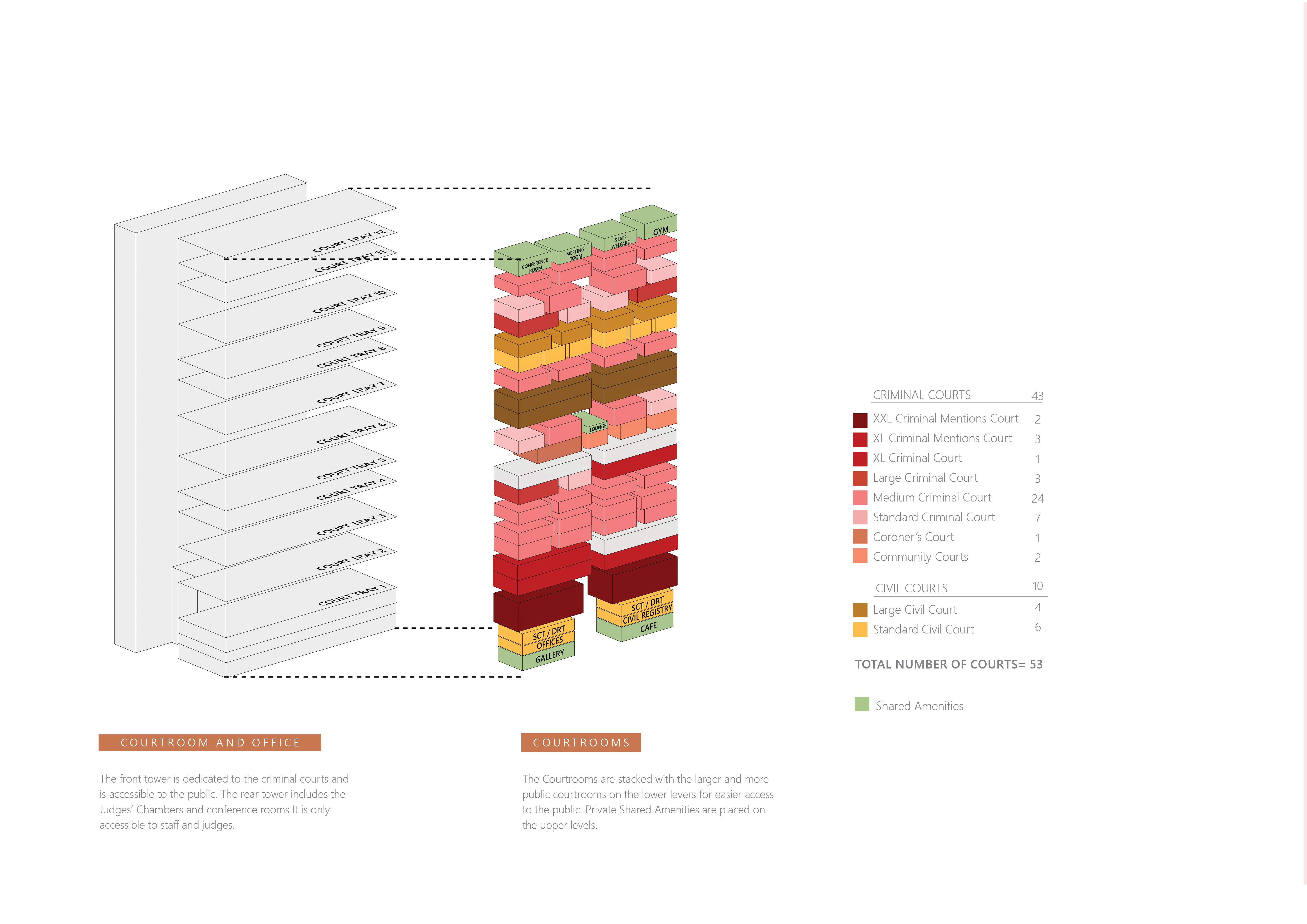
Illustration by CPG Consultants
(II) Various Court Tray Types
There are different combinations of numbers of courtroom boxes on each Court Tray. The Court Tray consists of two main heights – Double Volume and Single Volume. The landscape design of the sky terraces is varied as a result of these two factors. There is no external glazed facade.
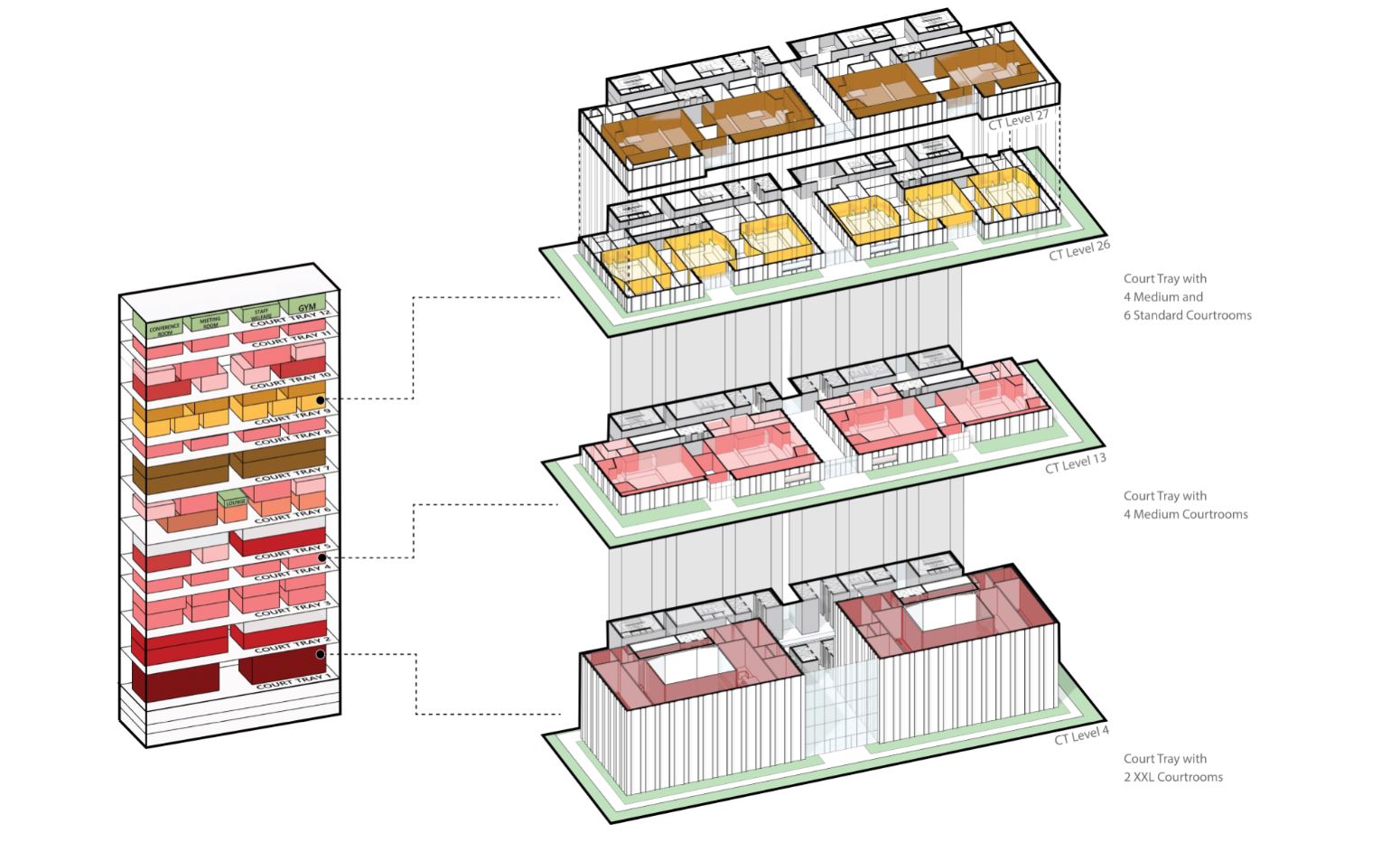
Illustration by CPG Consultants
(2) An Articulation of Terracotta Tiles
The courtrooms have been designed with a contemporary approach. The open-frame design is an apt reflection of the transparency and fairness of the judicial system. To articulate the delicate undulation of the terracotta roofs of surrounding shop houses in Chinatown, the courtrooms are clad in pigmented pre-cast panels measuring 5 to 12 metres in height, inspired by the colours and textures of the tiled roofs in the adjacent, historic Chinatown shophouses.

Courtrooms with pre-cast panels inspired by terracotta roofs (Image Credit: Khoogj)
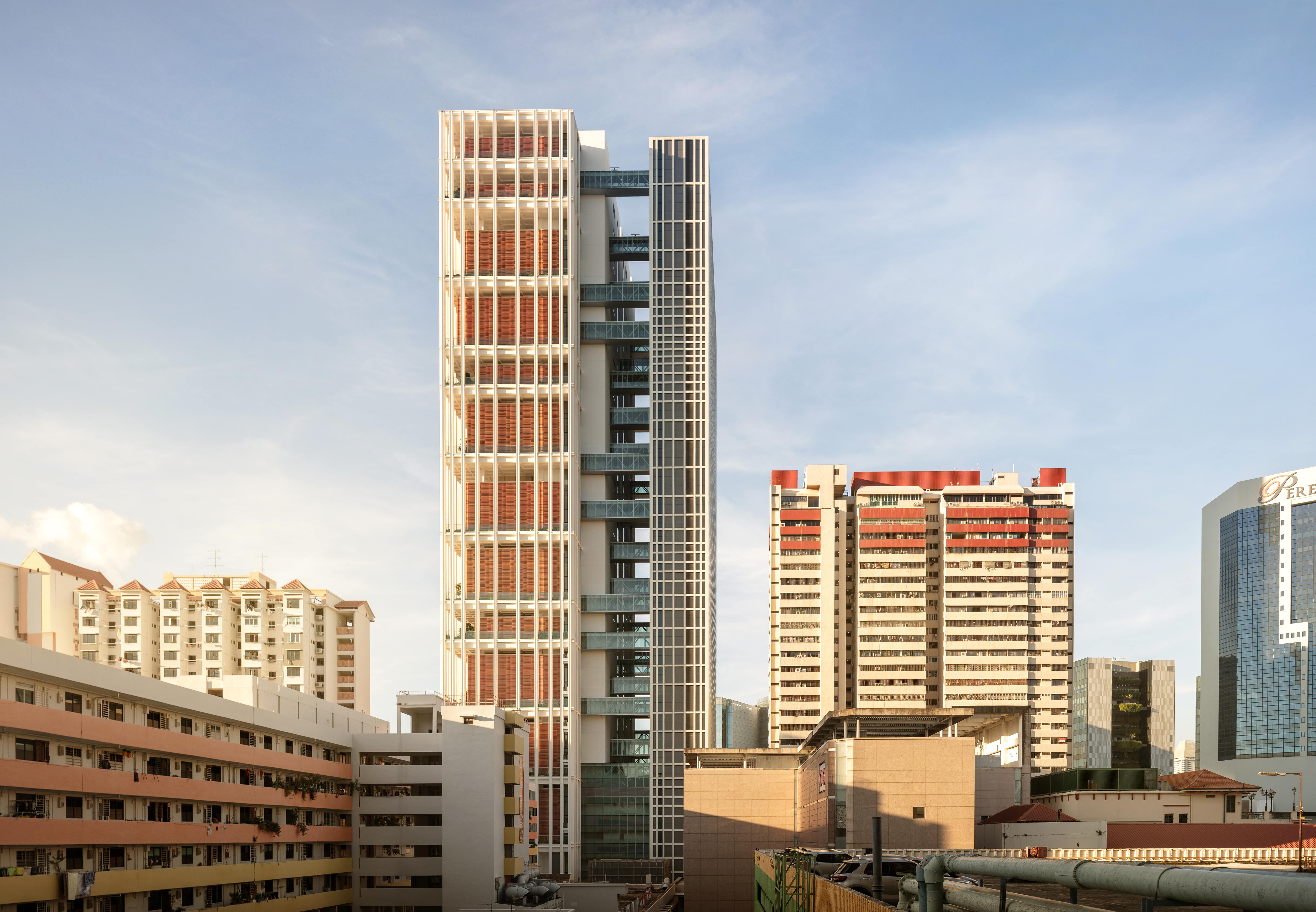
Facade of the new State Courts Towers (Image Credit: Finbarr Fallon)
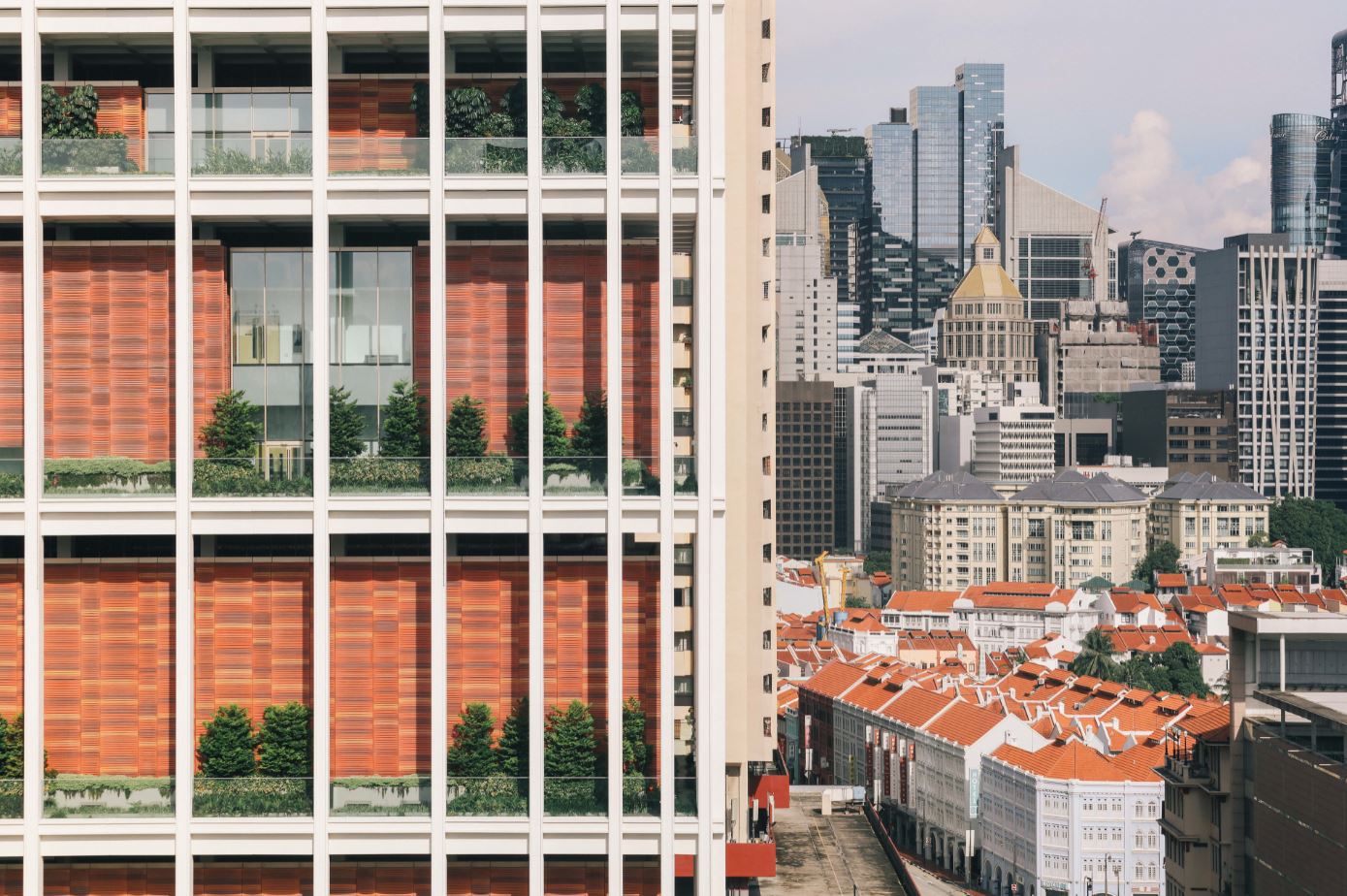
Terracotta roofs of shop houses in Chinatown, adjacent to the new State Courts Towers (Image Credit: Finbarr Fallon)
(3) Modern Courtroom Design Planning
The new States Courts Towers sets a criterion for modern courtrooms with its functional layout, contemporary Interior Design concept and smart technology.
A functional and typical courtroom layout needs to cater for the public, judges, court officers, counsel, persons-in-custody docks, media and transcribers.
Zoning of the 3 main users and mindful of the 3 separated basic circulations – Judges, Persons-in-Custody and the Public also happens on a micro scale in the courtroom layout.
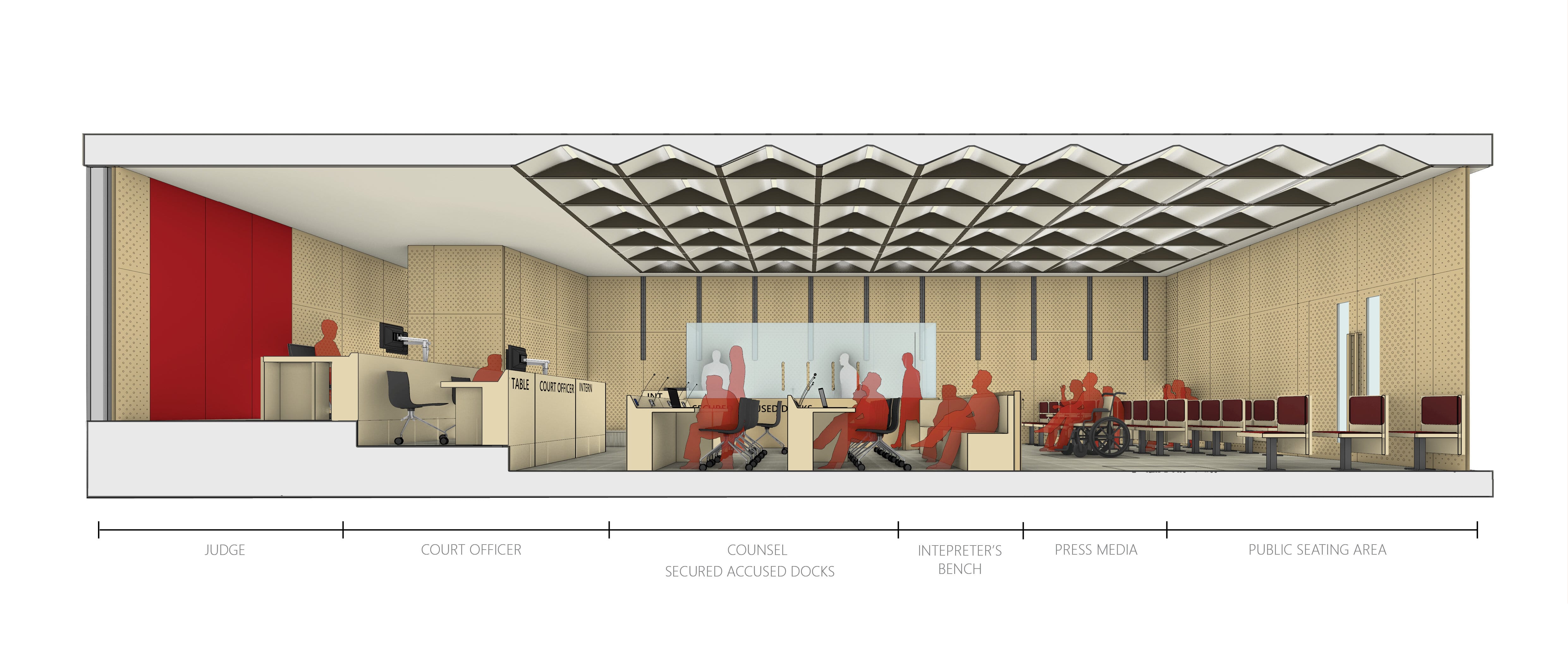
Illustration by CPG Consultants

Illustration by CPG Consultants



